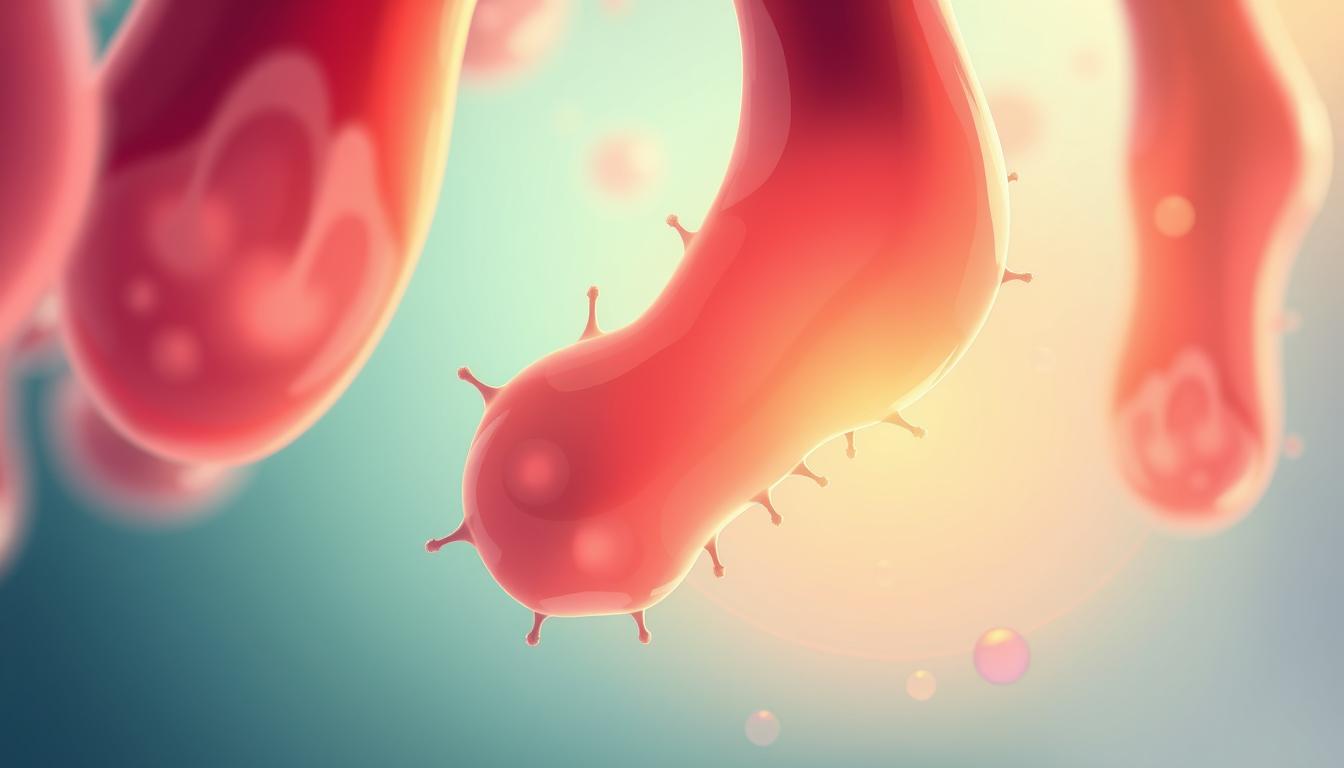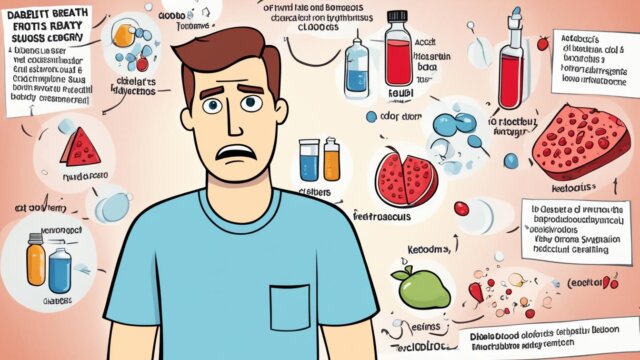FTC disclaimer: This post may contains affiliate links and we will be compensated if you click on a link and make a purchase.
Every year, over 14,000 people in the UK get lymphoma, making it the top blood cancer. It’s also the most common cancer in young adults. Lymphoma is a group of cancers that start in the lymphatic system. This system is key to our immune defense.
It happens when certain white blood cells grow too much. This leads to tumors in lymph nodes and other places. There are different types of lymphoma, like Hodgkin and non-Hodgkin. Treatments vary based on the type and how far it has spread.
Key Takeaways
- Lymphoma is a type of cancer that originates in the lymphatic system, a crucial part of the body’s immune defense.
- There are two main categories of lymphoma: Hodgkin lymphoma and non-Hodgkin lymphoma.
- Lymphoma treatments can include chemotherapy, radiotherapy, and targeted therapies.
- Lymphoma is one of the most common cancers in young adults.
- Early detection and effective management of lymphoma are crucial for improving outcomes.
What is Lymphoma?
Lymphoma is a cancer that starts in the lymphatic system. This system is key to our immune health. It makes lymphocytes, white blood cells that fight infections. In lymphoma, these cells grow too much and form tumors.
Overview of Lymphoma
Lymphoma is not very common. Non-Hodgkin lymphoma happens more often than Hodgkin lymphoma. Most people with non-Hodgkin lymphoma are over 65.
Hodgkin lymphoma often affects young adults and older people.
Types of Lymphoma: Hodgkin’s and Non-Hodgkin’s
There are two main types of lymphoma: Hodgkin and non-Hodgkin. Hodgkin lymphoma has Reed-Sternberg cells and follows a certain pattern. Non-Hodgkin lymphoma doesn’t have these cells and is more common.
About 90% of lymphoma is non-Hodgkin, and 10% is Hodgkin. B-cell lymphomas make up 80% of non-Hodgkin cases. T-cell lymphomas are less common.

“Hodgkin lymphoma can be diagnosed by the presence of Reed-Sternberg cells and is curable in many cases with treatments like chemotherapy and stem cell transplants.”
Causes and Risk Factors of Lymphoma
Lymphoma is a complex disease with many causes and risk factors. The exact DNA mutations that start lymphoma are not always known. But, researchers have found several key factors that raise a person’s risk of this cancer.
Age and Lymphoma Risk
Age is a big factor in lymphoma. Most non-Hodgkin lymphoma is more common in older people. This is because genetic mutations build up over time. Hodgkin lymphoma, however, is more common in people aged 15 to 34 or over 60. Also, men are more likely to get non-Hodgkin lymphoma than women.
Immune System Disorders and Lymphoma
Having a weakened immune system can also raise the risk of lymphoma. Autoimmune diseases like rheumatoid arthritis and lupus increase the risk of NHL. People with HIV or those who have had transplants also face a higher risk.
Infections Associated with Lymphoma
Certain infections can increase the risk of lymphoma. Epstein-Barr virus (EBV) infection is linked to Hodgkin lymphoma and other types of lymphoma. Hepatitis C virus (HCV) infection is also connected to NHL. Bacterial infections like Helicobacter pylori have been linked to some lymphomas.
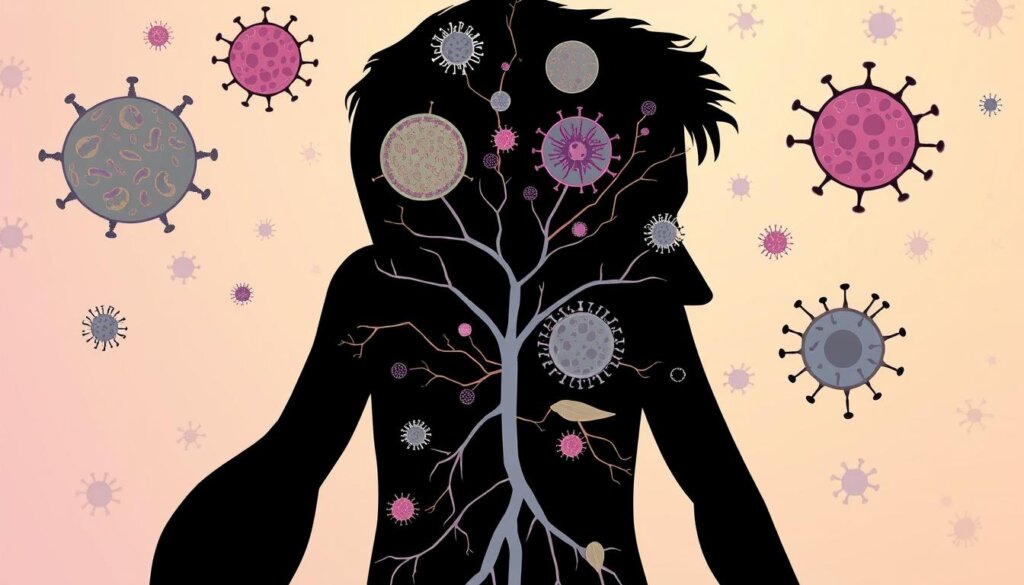
Even though we don’t know all the causes of lymphoma, knowing the risk factors helps. It helps both individuals and healthcare providers watch for and catch the disease early.
Symptoms of Lymphoma
Lymphoma is a blood cancer that shows different symptoms. Swollen lymph nodes are common, found in the neck, armpits, or groin. These nodes are smooth, round, painless, and feel rubbery.
Other symptoms include fever, unexplained weight loss, drenching night sweats, and persistent fatigue. Hodgkin lymphoma patients might also have itchy skin. These signs can mean lymphoma, but they can also be from other health issues. So, seeing a doctor is key if you have these symptoms.
Swollen Lymph Nodes
Swollen lymph nodes are a common sign of lymphoma. They are often felt as lumps under the skin in the neck, underarm, or groin. These nodes are usually smooth, round, and painless, with a rubbery feel.
Other Common Lymphoma Symptoms
Lymphoma can also cause other symptoms, including:
- Fever without an infection
- Drenching night sweats
- Unintended weight loss of at least 10% in 6 months
- Persistent fatigue
- Itchy skin (more common with Hodgkin lymphoma)
- Shortness of breath
These symptoms can mean lymphoma, but they can also be from other health issues. If you have these symptoms, it’s important to see a doctor for a check-up and diagnosis.
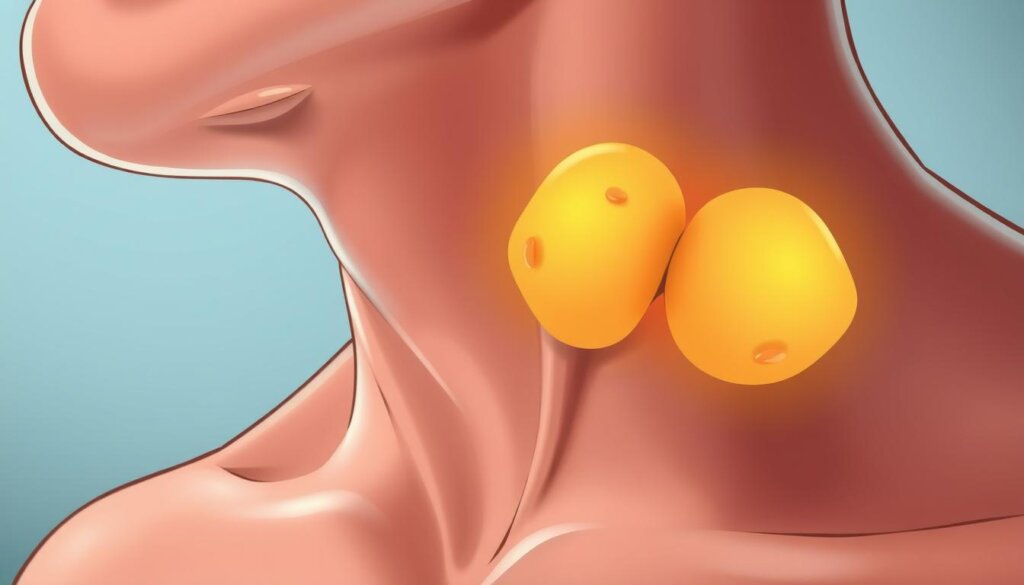
“Enlarged lymph nodes close to the body’s surface, though common in lymphoma, are mostly due to infections.”
Symptom | Description |
|---|---|
Swollen lymph nodes | Smooth, round, painless, and sometimes rubbery lymph node swellings, often in the neck, armpit, or groin |
Fever | Fever without an infection, often a sign of lymphoma |
Night sweats | Drenching night sweats, a common symptom of lymphoma |
Weight loss | Unexplained weight loss of at least 10% in 6 months, a potential symptom of lymphoma |
Fatigue | Persistent fatigue, which can be a symptom of lymphoma or other health conditions |
Itchy skin | Itching without a rash, more common in Hodgkin lymphoma |
Shortness of breath | Difficulty breathing, a potential symptom of lymphoma |
Remember, these symptoms can mean lymphoma, but they can also be from other health issues. If you have these symptoms, it’s important to see a doctor for a check-up and diagnosis.
Diagnosis and Testing for Lymphoma
Diagnosing lymphoma starts with a detailed physical check-up. Your doctor will look for swollen lymph nodes in your neck, underarms, and groin. This step helps find any areas that might be affected by the disease.
Physical Examination
Your doctor will also check your lymph nodes’ size and feel. They will look for an enlarged spleen or liver too. This first check gives clues about lymphoma’s presence and type.
Lymph Node Biopsy
If lymphoma is thought to be present, a lymph node biopsy is next. This involves taking a small lymph node sample for lab tests. The biopsy results will show if lymphoma cells are there and what type it is.
Bone Marrow Biopsy
Your doctor might also suggest a bone marrow biopsy. This test looks for any bone marrow issues that could point to lymphoma.
Imaging Tests for Lymphoma
Imaging tests like CT scans, PET scans, and MRI scans are used to see how far lymphoma has spread. These tests help find lymphoma in other body parts and guide treatment plans.
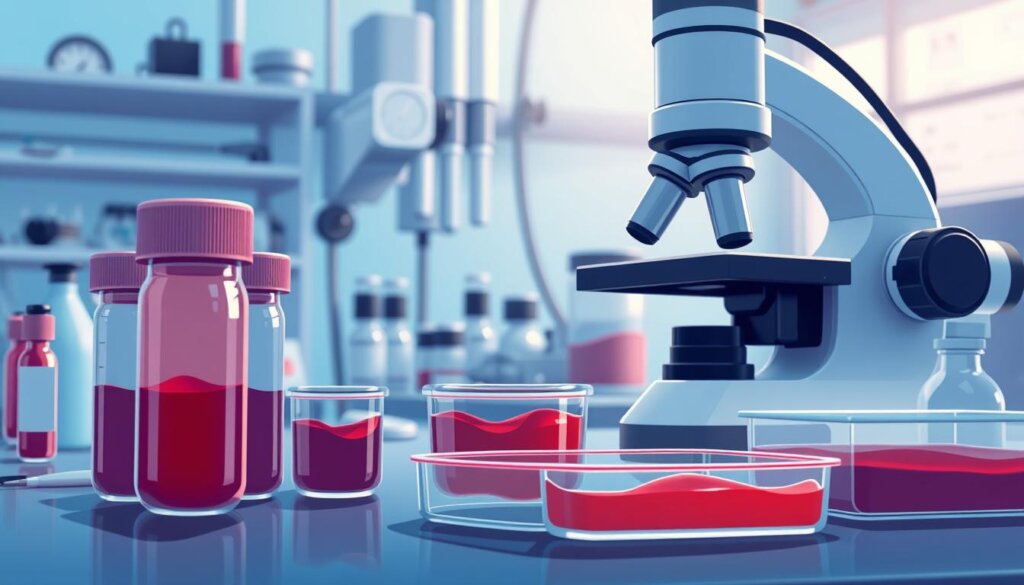
Getting a full diagnosis is key to treating lymphoma well. Your healthcare team will make sure you get all the tests you need. They will work with you to find the best treatment plan.
Treatment Options for Lymphoma
Treating lymphoma is all about finding the right fit for each patient. This means looking at the type and stage of the disease, and the patient’s health. The main ways to treat lymphoma are chemotherapy, targeted therapy, and immunotherapy. These methods aim to put the cancer into remission and improve life quality.
Chemotherapy for Lymphoma
Hodgkin lymphoma patients often get a mix of chemotherapy, radiation, immunotherapy, or stem cell transplant. Non-Hodgkin lymphoma patients might get chemotherapy, radiation, or a mix of these. They might also get bone marrow or stem cell transplant, or CAR T-cell therapy. Chemotherapy can be given through a vein or by mouth, lasting a few months. It can cause side effects like tiredness, getting sick easily, and hair loss.
Targeted Therapy for Lymphoma
Targeted therapies in lymphoma aim to stop specific proteins that help tumors grow and spread. Monoclonal antibody therapy can be used alone or with chemotherapy to lower cancer coming back. Rituximab is a common antibody medicine for lymphoma, causing side effects like nausea and hair loss.
Immunotherapy for Lymphoma
Immunotherapy uses the body’s immune system to fight cancer. For some non-Hodgkin lymphoma, it’s not curable but can lead to over 20 years of survival after diagnosis. For older or less fit patients, treatments might be adjusted to be less intense.
Patients should think about joining clinical trials for new treatments. Being involved in treatment decisions is key to managing healthcare effectively.
“The main treatment options for non-Hodgkin lymphoma (NHL) include chemotherapy, targeted and immunotherapy cancer drugs, steroids, radiotherapy, and stem cell transplant.”
Active Surveillance and Watchful Waiting
If you have slow-growing lymphoma, your doctor might suggest active surveillance or watchful waiting. This means watching the disease closely but not treating it right away. You’ll only start treatment if the lymphoma starts to bother you or gets worse.
With active surveillance, you’ll see your doctor often. They’ll check your vital signs, do physical exams, and take blood tests. These tests check for changes in your blood and organs. They might do CT scans or MRIs if they think the lymphoma is growing.
Watchful waiting is often suggested for certain types of lymphoma. You’ll see your doctor every 3 to 6 months. They’ll look for symptoms or changes in your lymph nodes. They might also do blood tests, scans, and biopsies to see how the disease is doing.
The good thing about these approaches is you might avoid treatment’s side effects. Some people might not need treatment at all. But if you notice symptoms like weight loss, fever, or fatigue, tell your doctor right away.
Living a healthy lifestyle helps too. Eating well, exercising, quitting smoking, and drinking in moderation are good choices. Your doctor will help you figure out the best way to manage your lymphoma.
Coping with a Lymphoma Diagnosis
Getting a lymphoma diagnosis can feel overwhelming. But, with the right help, patients can get through it and stay emotionally strong. Shock, denial, fear, and anxiety are common feelings. People struggle with the disease and feel out of control.
Anger, sadness, and guilt can also show up. It’s all part of trying to understand what’s happening.
Seeking Support and Information
Finding reliable info and support is key. Talking to patient groups, online forums, and doctors can help a lot. Being involved in treatment and staying positive can improve outcomes.
Maintaining Emotional Well-being
Patients might feel numb or very emotional after a diagnosis. Anxiety levels differ, and high anxiety can hurt sleep, pain, and overall health. Depression can also affect life quality during and after treatment.
Anger is another common feeling. It can range from mild to intense, often tied to fear, frustration, or helplessness.
To stay emotionally well, patients should think about counseling and stress-reduction methods. Support from loved ones is also crucial. Relationships may change during this time, with some growing closer and others straining or ending.
Young people might worry about school and relationships. Middle-aged folks might fret about work. Older patients might worry about health and support systems.
By getting support, learning about the disease, and focusing on emotional health, patients can face lymphoma challenges head-on.
Lymphoma in Young Adults
Lymphoma is a common blood cancer in young adults aged 15 to 39. Every year, about 70,000 teens and young adults get cancer, and lymphoma is a big part of that. It’s the most common blood cancer in this age group.
Young adults might ignore early signs of lymphoma, which can delay getting help. Treatments can cause hair loss, scars, and weight changes. These changes can be hard for young adults to handle.
Dealing with lymphoma means finding the right doctors and handling school and work. It also means dealing with insurance and money problems. A lymphoma diagnosis can really affect a young adult’s life plans.
But, there’s help for young adults with lymphoma. The Lymphoma Research Foundation has programs for them. A care plan is also important for their long-term health.
Understanding young adults’ challenges with lymphoma helps everyone help them. Healthcare providers, support groups, and the community can all play a part. Together, they can make sure young adults get the care and support they need.
Research and Clinical Trials for Lymphoma
Ongoing lymphoma research and clinical trials are key to fighting this disease. Researchers are looking into new treatments like targeted drugs and immunotherapies. These aim to better the lives of lymphoma patients.
Clinical trials offer patients a chance to try new treatments. This can give hope to those with hard-to-treat lymphoma. The Memorial Sloan Kettering (MSK) Lymphoma Service has a big program for Hodgkin and non-Hodgkin lymphoma.
- Many drugs that help patients have come from MSK trials.
- MSK offers new treatments not found elsewhere, which could be tomorrow’s cures.
- Studies cover all stages of the disease, showing a wide research effort.
Studies include phases 1, 2, and 3, testing drugs like Zanubrutinib and Venetoclax for lymphomas. There’s a focus on older patients and those with certain types of lymphoma.
Lymphoma Type | Clinical Trials |
|---|---|
Newly Diagnosed Aggressive Lymphoma | 7 studies |
Previously Treated Aggressive Lymphoma | 6 studies |
Newly Diagnosed Indolent Lymphoma | 2 studies |
Previously Treated Indolent Lymphoma | 6 studies |
Myeloma CAR T/Cell Therapy | 2 studies |
Studies test new drug combinations and immunotherapies, showing a wide range of treatments. Some trials focus on patients with AIDS-related lymphomas, showing a specialized approach.
Research into specific types like Hodgkin and T-Cell Lymphoma shows a detailed approach to treatment. Ongoing trials reflect a constant effort to improve lymphoma treatment.
“The availability of clinical trials is essential for advancing lymphoma treatment and providing patients with the most promising new therapies.”
Prognosis and Survival Rates for Lymphoma
Lymphoma’s outlook and survival chances vary a lot. This depends on the type of lymphoma, its stage, and the patient’s health. Averages give a general idea, but each person’s situation is different. Talking to a healthcare team is key to understanding your own situation.
For Non-Hodgkin lymphoma (NHL), the 5-year survival rate is 74%. But, survival rates differ based on the type and stage of the disease. Diffuse Large B-cell Lymphoma (DLBCL) has survival rates from 73% to 58%. Follicular Lymphoma (FL) has better rates, from 97% to 87%.
Hodgkin lymphoma has higher survival rates. For localized disease, it’s 93%. For distant disease, it’s 83%. The overall 5-year survival rate is 89%. But, other factors like age and blood counts also play a role.
Lymphoma Type | 5-Year Relative Survival Rates by Stage |
|---|---|
Non-Hodgkin Lymphoma (NHL) |
|
Follicular Lymphoma (FL) |
|
Hodgkin Lymphoma |
|
Other factors like the International Prognostic Index (IPI) and the Follicular Lymphoma International Prognostic Index (FLIPI) also matter. These tools help doctors predict outcomes. They look at age, stage, and other health details to guide treatment.
Remember, these numbers are just a guide. Each person’s journey with lymphoma is unique. Discussing your situation with your healthcare team is crucial. They can offer personalized advice based on your specific case.
“Lymphoma prognosis and survival rates are important, but they can’t predict the future with certainty. Each patient’s journey is unique, and with the right care and support, many people with lymphoma can achieve positive outcomes.”
Conclusion
Lymphoma is a complex blood cancer that starts in the lymphatic system. It affects the growth and behavior of lymphocytes. It’s important for patients to know about the different types of lymphoma, their causes, and treatment options.
Getting a lymphoma diagnosis can be scary. But, thanks to research, treatments have gotten better. This has improved the chances of survival for many patients.
The five-year survival rate for Hodgkin lymphoma is 86.6%, and for Non-Hodgkin lymphoma, it’s 72.0%. Modern treatments can cure about 70% of aggressive non-Hodgkin lymphoma cases. By seeking support and staying informed, those with lymphoma can face their journey with hope.
It’s key for patients and their families to understand lymphoma well. Lymphoma often strikes people aged 63 and older. By keeping up with the latest in lymphoma research and treatment, you can make informed decisions about your care.
FAQ
What is lymphoma?
Lymphoma is a type of cancer that starts in the lymphatic system. It happens when lymphocytes grow too much. This causes tumors in lymph nodes and other places in the body.
What are the main types of lymphoma?
There are two main types: Hodgkin lymphoma and non-Hodgkin lymphoma. Hodgkin lymphoma has Reed-Sternberg cells. Non-Hodgkin lymphoma does not.
What are the risk factors for developing lymphoma?
Risk factors include age and weakened immune systems. Certain infections like Epstein-Barr virus also increase risk.
What are the common symptoms of lymphoma?
Symptoms include swollen lymph nodes and fever. Weight loss, night sweats, and fatigue are also common. Hodgkin lymphoma may cause itchy skin.
How is lymphoma diagnosed?
Diagnosis involves a physical exam and lymph node biopsy. Imaging tests like CT scans are used to check for cancer in other areas.
What are the treatment options for lymphoma?
Treatments include chemotherapy, targeted therapy, and immunotherapy. The plan depends on the lymphoma type, stage, and health.
What is active surveillance or “watchful waiting” for lymphoma?
It’s for slow-growing lymphomas. It means watching the disease closely without starting treatment right away. Treatment starts when needed.
How can patients cope with a lymphoma diagnosis?
Patients can find reliable info and join support groups. They should also focus on emotional well-being through counseling and stress-reduction.
What are the unique challenges for young adults with lymphoma?
Young adults face challenges like balancing work and school with treatment. They also deal with the emotional impact of cancer. Support and resources help them cope.
How are ongoing research and clinical trials advancing the treatment of lymphoma?
Research and trials are key to improving lymphoma treatment. They explore new therapies to better outcomes and quality of life for patients.
How do prognosis and survival rates vary for lymphoma patients?
Prognosis and survival rates vary by lymphoma type, stage, and health. Patients should talk to their healthcare team for personalized guidance.
